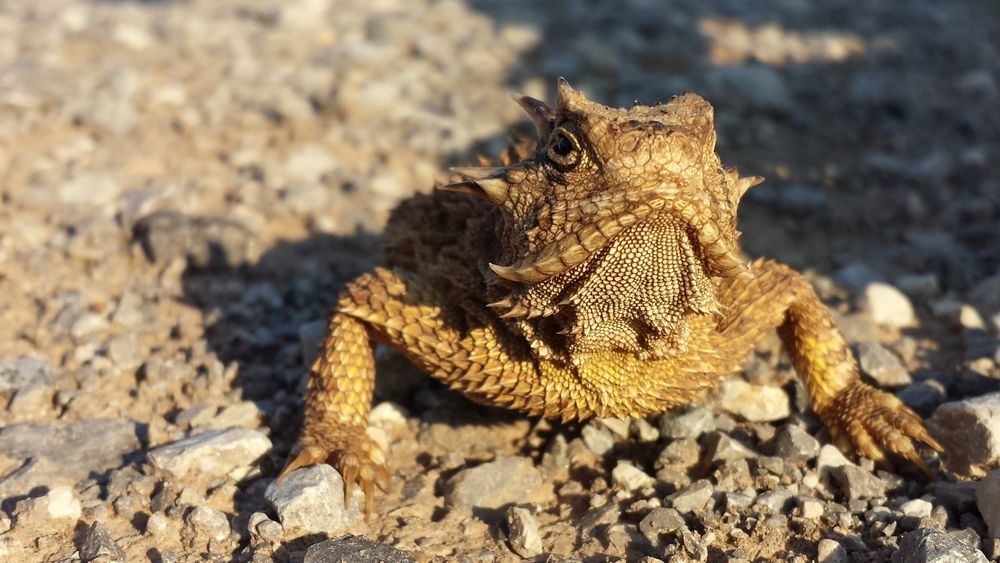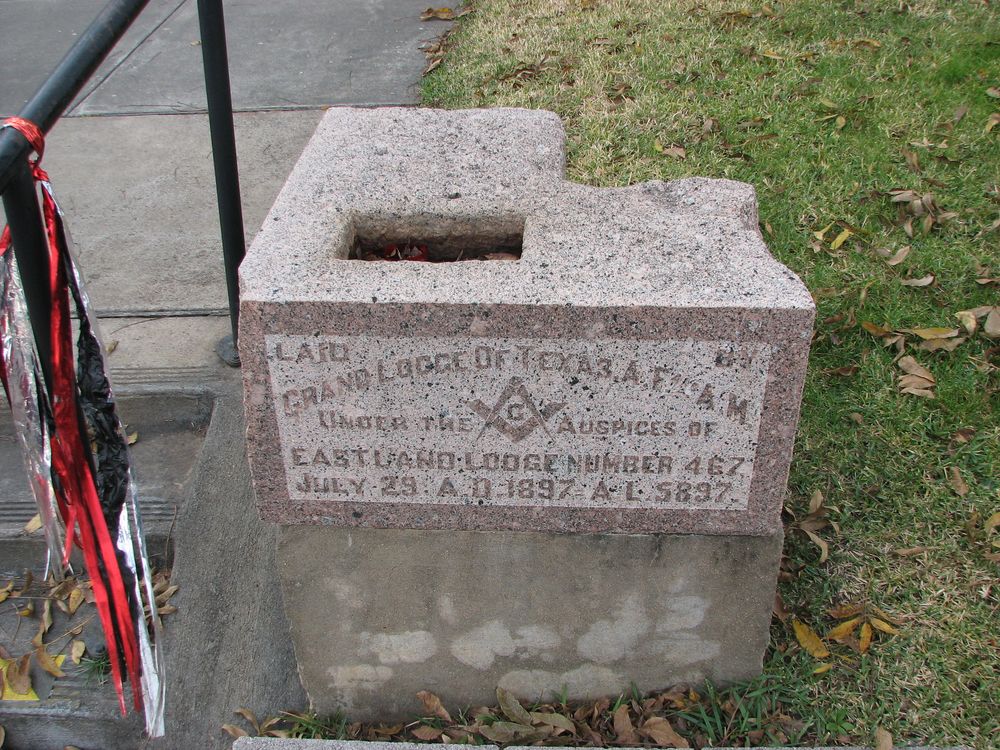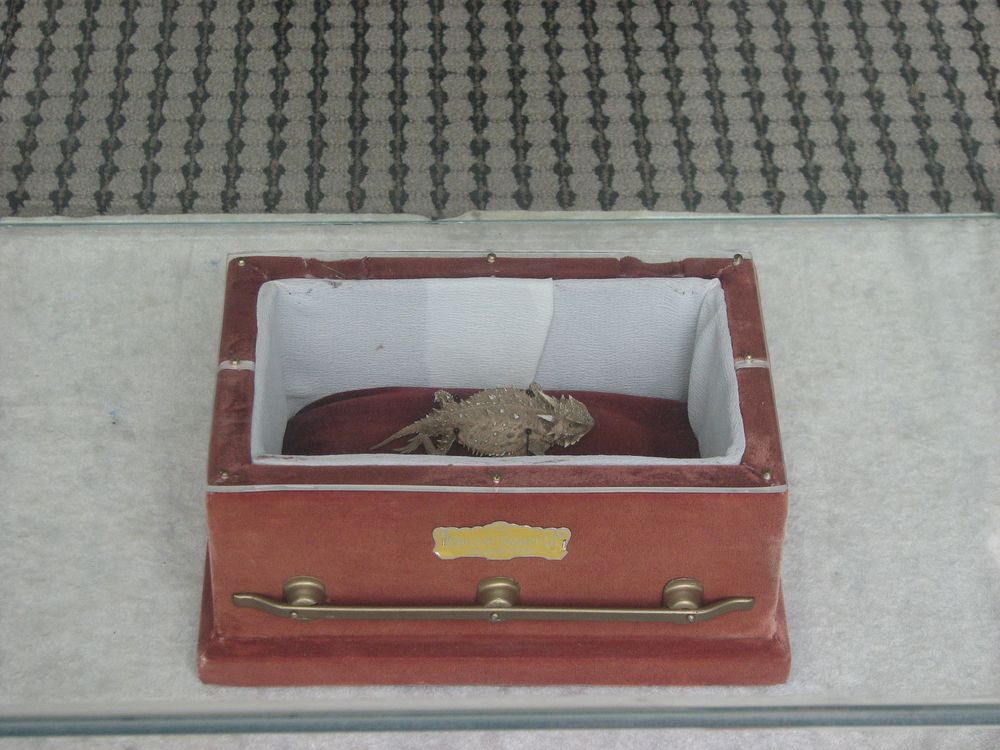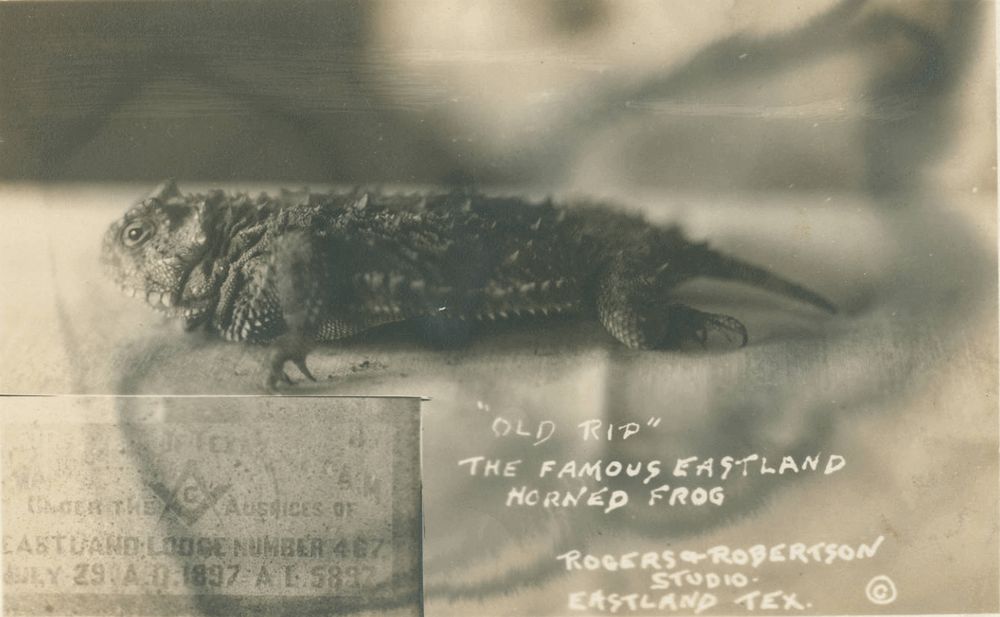The Texas horned lizard is a hardy creature, but its hardiness might have been overestimated. The Native American legend holds that the rugged species could survive up to 100 years in hibernation.
So when a 4-year-old boy named Will Wood caught a horny toad in Eastland County, Texas, one July morning in 1897, his father, Eastland County clerk Ernest E. Wood, decided to use the reptile to test the ancient belief. The horned lizard (named Blinky by Will) was placed in a cornerstone of the Eastland’s under-construction courthouse along with other time capsule memorabilia, including a Bible, several newspapers and coins, and a bottle of alcohol.

Texas horned lizard. Photo: Paul Hurtado/Flickr
Thirty years went by and Eastland County had grown and needed a newer, bigger courthouse, which meant that the old one had to be demolished. Everyone had forgotten about the horned toad except for Ernest, who told the local newspaper about it. An ambitious young newspaperman named Boyce House got wind of the story and published a sensational account of the toad supposedly entombed in the capsule for three decades.
On February 18, 1928, the day the vault was to be cracked open, a crowd of 1,500 onlookers gathered around the rubble of the old courthouse. At exactly four in the afternoon, the brick wall was pulled away from the cornerstone. Then the layer of cement that was over the top of the stone was chipped away and a sheet of metal covering the small cavity was lifted up.
Rev. Frank E. Singleton, a Methodist pastor, who observed the procedure peered into the cornerstone, levelled a finger and called out: 'There's the frog!'
Eugene Day, a local oilman and brother-in-law to Ernest E. Wood, reached into the cavity and lifted out a flat dusty horned lizard, which he handed it to Singleton. The pastor passed the creature to Judge Pritchard who raised the reptile high so that all might see it. Suddenly the lizard’s hind leg twitched. "He's alive!" Pritchard yelled, and the crowd roared in admiration.

Photo: rarenewspapers.com
Blinky was renamed Ol’ Rip, after Rip Van Winkle, and he became a national celebrity. The docile lizard went on a national tour, and Will Wood, now a middle-aged man, himself went along with Old Rip. At the Zoological Gardens in St. Louis, Missouri, Ol’ Rip was mobbed by forty thousand spectators. Later that same year in New York City, motion pictures produced with Will Wood introducing Ol' Rip, and “a bug-catcher was paid 50 cents each for insects that the frog devoured to please the camera man.”
In May 1928, the lizard went to Washington, D.C. to meet President Calvin Coolidge. A newspaper article reported the meeting:
President Coolidge asked numerous questions concerning his celebrated guest; stroked the frog's back with his horn-rimmed glasses, and then President and Old Rip gazed steadily at each other for a full minute without a sound—Silent Cal had met his match.
Meanwhile, zoologists and other scientists debated whether a Texas horned toad could survive for such an extended period of time without water, sunlight or oxygen. Dr. Raymond L. Ditmars, curator of mammals and reptiles at the Bronx Zoo, declared the alleged survival of the entombed lizard in Eastland, Texas, to be “utterly impossible.” Indeed, the typical lifespan of the horned lizard is between five to seven years. Will Wood, however, believed that the entombed animal survived due to the presence of a copy of Bible near it.

The cornerstone where Old Rip was entombed. Photo: QuesterMark/Flickr
Demand for horned lizard exploded across the country. The Texas Parks and Wildlife magazine reported that a local gas station offered a horned lizard with each fill-up. The Dallas Advertising League quickly sold 600 lizards at the International Advertising Association of the World convention in Detroit. At the Democratic National Convention in Houston, Texas, horned lizards were sold as souvenirs at $2.50 a piece. So many horned lizards were captured and exported out of West Texas that the Department of Agriculture warned of impending crop damage amounting to thousands of dollars if the shipments did not stop, as horned lizards preyed on insects that devoured local crops.
Back in Eastland, Old Rip was kept in a goldfish bowl in a store window, where he entertained visitors by eating harvester ants. The famed lizard lived for another eleven months, after being rescued from the cornerstone, before he finally bit the dust.

Old Rip in his coffin at the Eastland County Courthouse. Photo: QuesterMark/Flickr
Will Wood had Old Rip embalmed and placed in a tiny velvet-lined casket, which was kept on display in the lobby of the new Eastland courthouse. Old Rip became a part of Eastland culture for decades. The city began hosting annual events in Old Rip's honor—Old Rip Day, the Horned Toad Derby, Rip's Ribs Cook-Off, and a city-wide party named Rip Fest. There opened an Old Rip Café, Old Rip Cap Co. and an Old Rip soda, produced by a local bottling company. Legendary cartoon director Chuck Jones immortalized the story of Old Rip in an animated theatrical short entitled One Froggy Evening, where a ragtime-singing reptile named Michigan J. Frog had been freed, like Rip, from a cornerstone.
In 1962, Old Rip suffered a small mishap when politician John Connally, while running for governor of Texas, visited the courthouse for a publicity event and unceremoniously lifted the embalmed creature by its hind leg and the leg detached.
Twice Old Rip’s desiccated body got stolen, and a ransom demanded. Each time it was recovered, although doubts has been raised whether the recovered specimen was the same one that got kidnapped. The most damning evidence being that the found toad inexplicable had four intact feet instead of three in the original specimen.

A postcard of Old Rip. Photo: SMU Libraries
In 1976, an angry citizen sent an anonymous letter to newspapers claiming the original, three-footed specimen was still in the thief's possession and the City of Eastland had replaced the original specimen with a fake. The letter accused the city of “building its future around a dried-up horned frog”, and the writer offered to pay $5,000 to anyone who could prove the toad in the courthouse was truly Old Rip.
Despite its celebrity status, Old Rip’s species is gradually disappearing from East and Central Texas, presumably due to the overuse of pesticides and the spread of nonnative, red imported fire ants that destroyed colonies of harvester ant, the horned lizards' main food. The Texas horned lizard is now a protected species, and, in Texas, it is illegal to take, possess, transport or sell them without a special permit.












Comments
Post a Comment